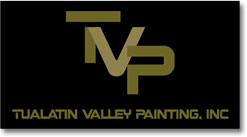Tualatin Valley Painting Blog
Surface Preparation, The secret to Long Paint Life
Always think of the entire coatings system as a single unit especially when selecting coatings for exterior and interior surfaces. Choose a top coating with regard to the primer and surface over which it will be applied. Conversely select an undercoat that is conrpatible with the top coat and the substrate, and be sure to buy quality products.
As a rule, good results and long paint life are more dependent on correct surface preparation for exterior paint than for interior paint; adequate surface preparation is important for both. Over 80% of all paint failures can be attributed to poor or improper surface preparation. Several examples follow.
Moisture can cause peeling paint on the lower part of stucco or other masonary walls. Water entering the ground can be absorbed into masonry, then rnigrate upward and, warmed by the sun, create water vapor pressure on the back side of the paint film. This problem is often accompanied by a white crystalline deposit on the paint and a general decomposition of the masonry itself. Applying a waterproofing compound to the surface of the paint will NOT help. Water must be stopped before it enters the masonary below the ground. Excavating and coating below grade surfaces with a coal tar or asphaltic coating will help.
Improving the drainage of the water away from the structure will also help. This problem of water wicking also occurs with wood in contact with the ground or areas of high moisture concentration (piled snow, siding adjacent to rain water down spouts, etc), causing the grain to swell. This in turn causes the paint to peel from the surface.
Two of the major causes of paint failure on exterior wood surfaces are either moisture passing through the substrate from the interior, or exterior sources of moisture getting behind the paint film. These may result from faulty flashing, lack of adequate ventilation in the house itself (i.e., ridge vents, soffit vents, attic vents) allowing trapped moisture to eveporate, improper or inadequate calking, or a porous or cracked paint film, among others.
A clean surface is extremely important to both interior and exterior painting. To clean most surfaces prior to painting, use a mild detergent solution to remove accumulated dirt, chalk, and grim. Pressure washing with a portable high pressure washer is excellent for removal of dirt, surface contaminants, chalk, flaking and peeling paint from almost any exterior surface. After washing, rense the area thouroughly with water and allow to completely dry before painting with primer or finish coat.
Paint "chalking" is another problem. All exterior paints will "chalk" when continuously exposed to weather - some more than others. This chalking (a loose powder on the surface) must be removed or sealed to the surface with a clear surface sealer before repainting.
In mildew growth areas, exterior surfaces must be sterialized and cleaned properly before repainting.
Temperature and humidity have major effects upon drying and ultimately upon the characteristics of the paint film. These effects may impact the actual appearance and performance of the paint itself. Paint should be applied at temperature and humidity levels recommended by the paint manufactor.
We are happy to discuss your painting needs. Contact us at (503) 579-8201 or complete our Estimate Request Form.





